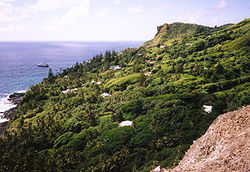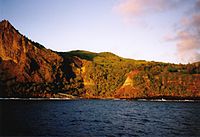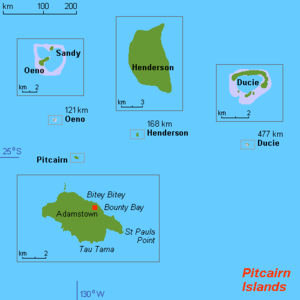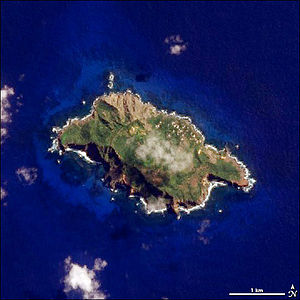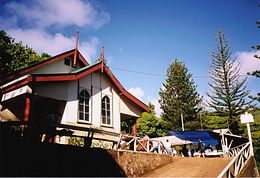Pitcairn Islands
| Pitcairn Islands (British overseas territory) | |
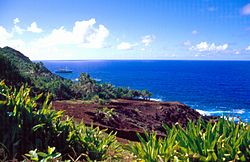 St Paul’s Point, Pitcairn Island | |
|---|---|
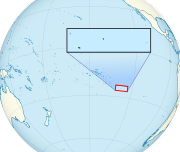
| |
| | |
| Population: | 50 (2008) |
| Capital: | Adamstown |
| Time zone: | GMT -8 |
| Dialling code: | +870 |
| TLD: | .pn |
The Pitcairn Islands, officially named the Pitcairn, Henderson, Ducie and Oeno Islands, form a group of four volcanic islands in the southern Pacific Ocean. The islands are a British overseas territory; the last remaining in the Pacific Ocean.
The four islands of the territory are spread over several hundred miles of ocean and have a total area of about 18 square miles. Only Pitcairn Island is inhabited; Pitcairn is the second largest of the islands, measuring about 2 miles across, and its population of just 50 souls is the whole population of the territory.
The islands are best known as home of the descendants of the Bounty mutineers and the Tahitians who accompanied them, an event retold in numerous books and films. This history is still apparent in the surnames of many of the islanders. With only about 50 inhabitants[1] (from four families as of 2010: Christian, Warren, Young, and Brown), Pitcairn is the least populous and most remote jurisdiction in the world.
Contents
Geography
The Pitcairn Islands form the south-easternmost extension of the geological archipelago of the Tuamotus, and consist of four islands: Pitcairn Island, Oeno Island (an atoll with five islets, one of which is Sandy Island), Henderson Island and Ducie Island (an atoll with four islets). The Pitcairn Islands were formed by a centre of upwelling magma called the Pitcairn hotspot.
The only permanently inhabited island, Pitcairn, is accessible only by boat at Bounty Bay.
Henderson Island, covering about 86% of the territory's total land area and supporting a rich variety of animals in its nearly inaccessible interior, is also capable of supporting a small human population, but access is difficult, owing to its outer shores' being steep limestone cliffs made of sharp coral. The other islands are at a distance of more than 60 miles and are not habitable.
| Island or atoll | Type | Land area (sq miles) |
Total area (sq miles) |
Pop. July 2008 |
Coordinates |
|---|---|---|---|---|---|
| Ducie Island | Atoll | 0.3 | 1.5* | – | |
| Henderson Island | Uplifted coral island | 14.4 | 14.7 | – | |
| Oeno Island | Atoll | 0.25 | 6.4* | – | |
| Pitcairn Island | Volcanic island | 1.8 | 1.8 | 50 | |
| Pitcairn Islands (all islands) |
– | 16.7 | 24.1 | 50 | 23°55′26″ to 25°04′00″S |
* Includes reef flat and lagoon of the atolls.
Flora and fauna
About nine plant species are thought to occur only on Pitcairn. These include tapau, formerly an important timber resource, and the giant nehe fern (‘’Angiopteris chauliodonta’’). Some, such as red berry (‘’Coprosma rapensis var. Benefica’’), are perilously close to extinction. The Pitcairn Islands are one of two places in the world in which the plant species Glochidion pitcairnense occurs.[2]
In terms of fauna, an interesting and rare introduction is the Galapagos giant tortoise (‘’Testudo elephantopus’’). The sole surviving tortoise, Ms T (also known as Turpen), was one of five, which arrived on Pitcairn between 1937 and 1951, brought to the island by Irving Johnson, skipper of the 96 foot Brigantine Yankee. Turpen usually resides at Tedside by Western Harbour. A protection order makes it an offence should anyone kill, injure, capture, maim or cause harm or distress to the tortoise.[3]
The birds of Pitcairn fall into several groups. These include seabirds, wading birds and a small number of resident land bird species. Of 20 breeding species, Henderson Island has 16, including the unique flightless Henderson rail (Nesophylax alter); Oeno 12; Ducie 13 and Pitcairn six. Of the birds breeding on Pitcairn the best known are the Fairy Tern (Gygis alba), the Common Noddy (Anous stolidus) and the Red-tailed Tropic Bird (Phaethon rubricauda). The Pitcairn Island Warbler (‘’Acrocephalus vaughani’’), known by Pitcairners as a "Sparrow", is a native species, dark-brown above and yellowish to buff below. It used to be common throughout the island but was placed on the endangered status list in 2008.
History
The original settlers of the Pitcairn Islands were Polynesians who appear to have lived on Pitcairn and Henderson for several centuries. Although archaeologists believe that Polynesians were living on Pitcairn as late as the 15th century, the islands were uninhabited when they were discovered by Europeans.
Ducie and Henderson Islands were discovered by Portuguese sailor Pedro Fernandes de Queirós, sailing for the Spanish Crown, who arrived on 26 January 1606. He named them La Encarnación ("The Incarnation") and San Juan Bautista ("Saint John the Baptist"), respectively. However, some sources express doubt about exactly which of the islands were visited and named by Queirós, suggesting that Queirós’ La Encarnación may actually have been Henderson Island, and San Juan Bautista may have been Pitcairn Island.[4]
Pitcairn Island was sighted on 3 July 1767 by the crew of the British sloop HMS Swallow, commanded by Captain Philip Carteret. It was named after Midshipman Robert Pitcairn, a fifteen-year-old crew member who was the first to sight the island. Robert Pitcairn was the son of British Marine Officer John Pitcairn.
Carteret, who sailed without the newly invented accurate marine chronometer, charted the island at 25° 2’ south and 133° 21’ west of Greenwich, but although the latitude was reasonably accurate the longitude was incorrect by about 3°. This made Pitcairn difficult to find, as highlighted by the failure of Captain James Cook to locate the island in July 1773.[5][6]
Settlement
In 1790, nine of the mutineers from the HMS ‘’Bounty’’ and Tahitian companions (six men, 11 women and a baby), settled on Pitcairn Island and set fire to the Bounty. The wreck is still visible underwater in Bounty Bay. The ship itself was discovered in 1957 by National Geographic explorer Luis Marden. Although the settlers were able to survive by farming and fishing, the initial period of settlement was marked by serious tensions among the settlers. Alcoholism, murder, disease and other ills took the lives of most mutineers and Tahitian men. John Adams and Ned Young turned to the scriptures using the ship's Bible as their guide for a new and peaceful society. Young eventually died of an asthmatic infection. The Pitcairners also converted to Christianity; later they would convert from their existing form of Christianity to Seventh-day Adventism after a successful Adventist mission in the 1890s. After the rediscovery of Pitcairn, John Adams was granted amnesty for his mutiny.
The Pitcairn islanders reported that it was not until 27 December 1795 that the first ship since the Bounty was seen from the island, but as she did not approach the land, they could not make out to what nation she belonged. A second appeared some time in 1801, but did not attempt to communicate with them. A third came sufficiently near to see their habitations, but did not venture to send a boat on shore. The American trading ship Topaz was the first to visit the island and communicate with them when they spent 10 hours at Pitcairn in February 1808. A report of Folger's find was forwarded to the Admiralty mentioning the mutineers and a more precise location of the island—25° 2’ S latitude, 130° W longitude[7]—however, this rediscovery was not known to Sir Thomas Staines, who commanded a Royal Navy flotilla of two ships (HMS Briton and HMS Tagus) which found the island at 25° .4’ S (by meridian observation) on 17 September 1814. Staines sent a party ashore and wrote a detailed report for the Admiralty.[8][9]
Ducie Island was rediscovered in 1791 by the British Captain Edwards aboard HMS Pandora, while searching for the Bounty mutineers. He named it after Francis Reynolds-Moreton, 3rd Baron Ducie, a captain in the Royal Navy. Henderson Island was rediscovered on 17 January 1819 by a British Captain James Henderson of the British East India Company ship Hercules. On 2 March 1819, Captain Henry King, sailing aboard the Elizabeth, landed on the island to find the king's colours already flying. His crew scratched the name of their ship into a tree, and for some years the island's name was Elizabeth or Henderson. Oeno Island was discovered on 26 January 1824 by the American Captain George Worth aboard the whaler Oeno.
British colony
Pitcairn Island became a British colony in 1838 and was among the first territories to extend voting rights to women. By the mid-1850s the Pitcairn community was outgrowing the island and its leaders appealed to the British government for assistance. They were offered Norfolk Island and on 3 May 1856, the entire community of 193 people set sail for Norfolk on board the Morayshire, arriving on 8 June after a miserable five-week trip. But after eighteen months on Norfolk, seventeen of the Pitcairners returned to their home island; five years later another twenty-seven did the same.
In 1902 Henderson, Oeno and Ducie islands were annexed by Britain, Henderson on 1 July, Oeno on 10 July and Ducie on 19 December.[10] In 1938 the three islands along with Pitcairn were formally incorporated into a single administrative unit called the "Pitcairn Group of Islands".
Since a population peak of 233 in 1937, the island has been suffering from emigration, primarily to New Zealand, leaving some fifty people living on Pitcairn (December 2009: 45 islanders on Electoral Roll)
Pitcairn’s close-knit society was rocked in 2004 when charges were laid against seven men living on Pitcairn and six living abroad with sex-related offences dating back a number of years, six of whom were convicted, including Steve Christian, the island's mayor at the time. After the six men lost their final appeal, the British government set up a prison on the island at Bob's Valley. The men began serving their sentences in late 2006, as of 2010 all men have served their sentences or been granted home detention status (Pitcairn News, 2010).
In 2010 the island received a new and updated constitution.[11]
Economy
The fertile soil of the Pitcairn valleys, like Isaac's Valley on the gentle slopes south-east of Adamstown, produces a wide variety of fruits: including bananas, papaya (paw paws), pineapples, mangoes, watermelons, rockmelons, passionfruit, breadfruit, coconuts, avocadoes, and citrus (including oranges, mandarins, grapefruit, lemons and limes); and vegetables include: sweet potatoes (kumura), carrots, sweet corn, tomatoes, taro, yams, peas, and beans. Arrowroot (Tacca leontopetaloides) and sugarcane are grown and harvested to produce arrowroot flour and molasses. Pitcairn Island is remarkably productive and its benign climate allows a wide range of tropical and temperate crops to be grown.[12]
Fish are plentiful in the seas around Pitcairn. Spiny lobster and a large variety of fish are caught for meals and for trading aboard passing ships. Almost every day someone will go fishing, whether it is from the rocks, from a longboat or diving with a spear gun. There are numerous types of fish around the island. Fish such as Nanwee, White Fish, Moi and Opapa are caught in shallow water, while Snapper, Big Eye and Cod are caught in deep water and Yellow Tail and Wahoo are caught by trolling. A range of minerals have been discovered within the Exclusive Economic Zone (EEZ), which extends 370 km offshore and comprises 880,000 km2, including manganese, iron, copper, gold, silver and zinc (Commonwealth Secretariat Yearbook 2010: Pitcairn Economy).
The Pitcairners are involved in creating crafts and curios (made out of wood from Henderson). Typical wood carvings include sharks, fish, whales, dolphins, turtles, vases, birds, walking sticks, book boxes and the famous models of the Bounty. Miro (Thespesia populnea), a dark, durable and beautifully grained wood, is preferred for carving. Islanders also produce exquisite tapa cloth and painted hattie leaves.[13]
The major sources of revenue, until recently, have been the sale of coins and postage stamps to collectors, .pn domain names, and the sale of handicrafts to passing ships, most of which are plying the United Kingdom to New Zealand route by way of the Panama Canal. Trade is restricted by the jagged geography of the island, which lacks a harbour or airstrip, forcing all trade to be made by longboat to visiting ships. Occasionally, passengers from expedition-type cruise ships will come ashore for a day, weather permitting.
In 1998, the UK Government aid agency, the Department for International Development, funded a bee-keeping programme for Pitcairn which included training for Pitcairn's beekeepers and a detailed analysis of Pitcairn's bees and honey with particular regard to the presence or not of disease. Pitcairn, it was discovered, has one of the best examples of disease-free bee populations anywhere in the world and the honey produced was and remains exceptionally high in quality. Pitcairn bees were also found to be a particularly placid variety and, within a short time, the beekeepers were able to work with them wearing minimal protection.[14] As a result, Pitcairn today exports its renowned honey to New Zealand and to the United Kingdom, where it is stocked in London by Fortnum and Mason and Partridges in Sloane Square. The honey has become a favourite of Her Majesty, Queen Elizabeth II and Prince Charles.[15] The Pitcairn Islanders, under the "Delectable Bounty" brand, also export dried fruits including bananas, papayas, pineapples and mangoes to New Zealand.
Culture
Language
The majority of the resident Pitcairn Islanders are the descendants of the Bounty mutineers and Tahitians. “Pitkern” is a creole language derived from 18th century English, with elements of the Tahitian language. It is spoken as a first language by the population and is taught alongside standard English at the island's only school. It is closely related to the creole language Norfuk, spoken on Norfolk Island, because Norfolk was repopulated in the mid-19th century by Pitcairners.
People
In September 2003, a baby was born on the island for the first time in 17 years. Another child, Adrianna Tracey Christian, was born on Pitcairn on 3 March 2007. In February 2005, Shirley and Simon Young became the first married outsider couple in recorded history to obtain citizenship on Pitcairn.
Churches
A successful Seventh-day Adventist mission in the 1890s was important in shaping Pitcairn society. In recent years, the church has declined, with only about eight islanders worshipping regularly, but most of them still attend church on special occasions.[16] The Sabbath is observed as a day of rest and as a mark of respect for observant Adventists.
The church which was built in 1954, is run by the Church board and resident pastor, who usually serves a two year term. The Sabbath School meets at 10 am on Saturday mornings and is followed by Divine Service an hour later. On Tuesday evenings there is a further service in the form of a prayer meeting.
Society
The once-strict moral codes, which prohibited dancing, public displays of affection, smoking, and consumption of alcohol, have been relaxed in recent years. Islanders and visitors no longer require a six-month licence to purchase, import, and consume alcohol. There is now one licensed café and bar on the island, and the Government Store sells alcohol and cigarettes. The unique cuisine and rich cultural heritage of the Pitcairn Islanders is detailed in a cookbook: "A Taste of Pitcairn: The First Pitcairn Island Cookbook", by Pitcairn resident Meralda Warren.
Fishing and swimming are two popular recreational activities. A birthday celebration or the arrival of a ship or yacht will involve the entire Pitcairn community in a public dinner in the Square, Adamstown. Tables are covered in a variety of foods, including fish, meat, chicken, philhi, baked rice, boiled plun (banana), breadfruit, vegetable dishes, an assortment of pies, bread, breadsticks, an array of desserts, pineapple, watermelon and more. There is never a shortage of food.
Public work, which by law is required of all men and women between the ages of 16 and 65, ensures the ongoing maintenance of the island's numerous roads and paths.
Education
Education is free and compulsory between the ages of five and 16. All of Pitcairn's seven children were enrolled in school in 2000. The island's children have produced a book in Pitkern and English called "Mi Bas Side orn Pitcairn=My Favourite Place on Pitcairn" (National Library of New Zealand Catalogue).
The school at Pulau provides pre-school and primary education based on the New Zealand syllabus. The teacher is appointed by the Governor from suitable qualified applicants who are New Zealand registered teachers. The contract includes the role of Editor of the Pitcairn Miscellany.
Media and communications
- Telephones: Pitcairn uses New Zealand's international dialling code, +64.
- Radio: There is no broadcast station. Marine band walkie-talkie radios are used to maintain contact among people in different areas of the island. Foreign stations can be picked up on Shortwave Radio.
- Amateur Radio: QRZ.COM lists seven amateur radio operators on the island.
- Television: There are 2 live English TV channels from satellite, CNN, and Turner Classic Movies. Free-To-Air satellite dishes can be used to watch foreign TV.
- Internet: There is one Government-sponsored satellite internet connection, with networking provided to the inhabitants of the island. Pitcairn's country code (top level domain) is .pn. Residents pay NZ$100 (about USD$75) for 2GB of bandwidth a month, at a rate of 256kbps.[17]
Transport
Pitcairn Island does not have an airport or seaport; the islanders rely on longboats to ferry people and goods between ship and shore through Bounty Bay. The island does have one small harbour and launch ramp that is used to dock and load long-boats, but it is so small and the water so shallow that only small-craft can fit.[18]
To get to Pitcairn today, you can travel on board Pitcairn's new dedicated Passenger / Cargo supply ship chartered by the Pitcairn Island Government, the MV Claymore II, from Mangareva in the Gambier Islands of French Polynesia. Mangareva itself is reachable by air from the French Polynesian capital Papeete.
There is one paved road leading up from Bounty Bay through Adamstown.
Gallery
References
- ↑ 2010 article mentioning island
- ↑ Pitcairn Islands Environment Management Plan, 2008
- ↑ Endangered Species Protection Ordinance, 2004 revised edition
- ↑ Pitcairn Islands, "History of Government and Laws, Part 15" 30 September 2006
- ↑ Hooker, Brian. "Down with Bligh - hurrah for Tahiti". Finding New Zealand. http://www.findingnz.co.nz/al/gal1_bounty.htm.
- ↑ Winthrop, Mark. "The Story of the Bounty Chronometer". Lareau Web Parlour. Archived from the original on 2007-09-27. http://web.archive.org/web/20070927005607/http://www.lareau.org/chrono.html. Retrieved 2008-09-17.
- ↑ "Mutineers of the Bounty". The European Magazine, and London Review (Philological Society of London,) 69: 134. January–June 1816. http://books.google.com/?id=mOwRAAAAYAAJ&pg=PA62#PPA134,M1.
- ↑ History of Pitcairn IslandHistory of Pitcairn Island, Pitcairn Study Centre. Retrieved 15 September 2008.
- ↑ Pitcairn descendants of the Bounty Mutineers. Retrieved 15 September 2008.
- ↑ Cahoon, Ben. "Pitcairn Island". worldstatesmen.org. http://www.worldstatesmen.org/Pitcairn.htm. Retrieved 4 July 2010.
- ↑ Presenter: Paul Allen Speaker: Pitcairn Island Governor, George Fergusson. Pitcairn Island proclaims new constitution. Radio Australia, March 11, 2010
- ↑ Secretariat of the Pacific Community (SPC): Pitcairn Islands - Joint Country Strategy, 2008
- ↑ Foreign and Commonwealth Office, Profile on Pitcairn Islands, British Overseas Territory, 11 February 2010
- ↑ The Telegraph, 9 January 2010
- ↑ Evening Standard, 8 January 2010 "I'll let you off, Mr Christian: you make honey fit for a queen"
- ↑ "Turning Point for Historic Adventist Community on Pitcairn Island" 30 September 2006
- ↑ "iPad Makes Its Way to the Farthest Reaches of the Earth" MacRumors.com, retrieved 2010-11-03
- ↑ ’’Pitkern Ilan’’, David Evans, 2007
Outside links
- Pitcairn Island Tourism Official tourism site of the Pitcairn Islands.
- Pitcairn Government
- Pitcairn Islands from the Foreign and Commonwealth Office
- Pitcairn Miscellany News from Pitcairn Island. Editor is Pulau school teacher.
- Pitcairn News Pitcairn information from Chris Double, a Bounty descendant based in Auckland New Zealand
- Uklun Tul Un Dem Tul Pitcairn news by Kari Young, a Pitcairn resident
